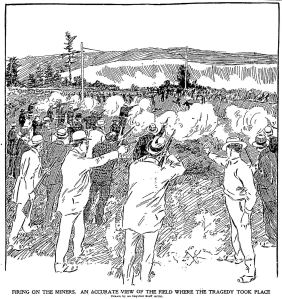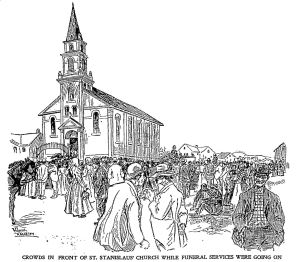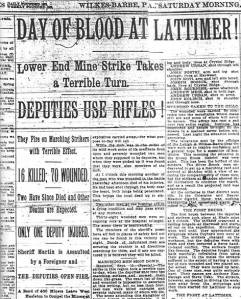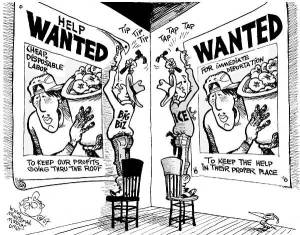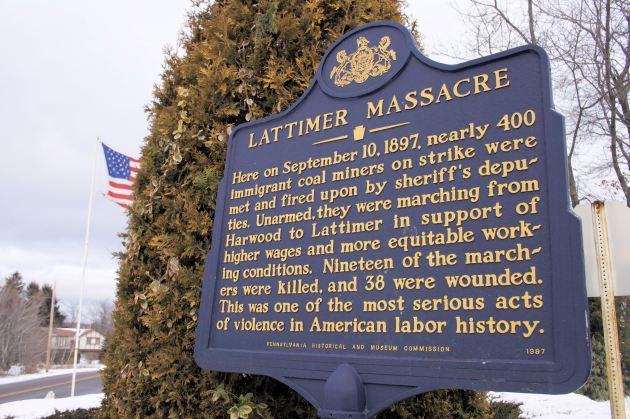Historic Newspaper Images
July 26, 2010 1 Comment
Annie from the Greater Hazleton Historical Society turned me on to a really great historic American newspapers database (Early American Newspapers, Series I-III), which turned up some of the articles mentioned and quoted in previous posts. While many of them leave scenes up to the imagination in a pre-photojournalist age, a few of them included really telling, sometimes powerful images. I hope you enjoy or are inspired by a few of them here:
(click on an image to enlarge)
“Firing on the Miners. An Accurate View of the Field Where the Tragedy Took Place” by a Philadelphia Inquirer staff person, 12 September 1897, front page. It looks like the deputies were amassed just north of the massacre monument, across Main St.
Again, a staff drawing from the 12 September 1897 Philadelphia Inquirer, this time page 4: “Identifying Bodies in the Stable of Undertaker Boyle”. I can’t imagine what that must have been like; although, I gather from talking with people in the region that this is possible more humane than usual. It used to be that the coal companies would just drop a dead body off at their home when someone died in a mine accident, right on the front porch.
“Crowds in Front of St. Stanislaus Church While Funeral Services Were Going On” in the Philadelphia Inquirer, 14 September 1897, front page.
From the New York Evening Journal, 10 March 1898, p. 5 (the signature appears to read “Davenport”). Granted, the New York Evening Journal’s articles were a little more sensational than other newspapers’ at the time; however, there must have been some sense that money and power came before justice, and public sentiment around the country must have in part been that the deputies were guilty of murder despite their acquittal. Of course, the other trial, which seemed certain for Sheriff Martin, never happened.
The title and date of this are really interesting – “Lattimer Deputies Again Carrying Arms, Ready to Murder More Strikers” in the New York Evening Journal, 17 March 1898 (I think the artist’s signature reads J.A. Williams). It must have looked like the deputies were still riled up against the miners, and again, that the deputies were in fact guilty of murder.
What a great image! Two years after the massacre this rendition of a not-so-blind justice appears in Narodny Kalendar, a Slovak publication. I’m working on trying to find an original copy, but meanwhile the image shows up in the journal Pennsylvania History: 2002 vol. 69 (1), p. 41. It’s in an article called “A Slovak Perspective on the Lattimer Massacre” by M. Mark Stolarik.
These and still more images are in the gallery, below.
– Kristin
(click on an image to enlarge)
- Narodny Kalendar, 1899
- Officers of Troops. Philadelphia Inquirer 19 Sept. 1897, p.7
- Map of the Middle Coal Fields. Philadelphia Inquirer, 12 September 1897
- The Pay Line by Jay Hambidge. The Century, April 1898 (p. 812-13).
- New York Evening Journal, 10 March 1898 p. 5
- Lattimer Breaker. The Century, April 1898 (p. 819), by Jay Hambidge
- Philadelphia Inquirer, 12 September 1897
- Philadelphia Inquirer, 12 September 1897
- NY Evening Journal, 17 March 1898
- 12th Regiment. Philadelphia Inquirer, 19 Sept. 1897
- Milnesville Hotel. Philadelphia Inquirer, 12 September 1897
- Sheriff Martin. Philadelphia Inquirer, 12 Sept. 1897, p.4
- Philadelphia Inquirer, 14 September 1897
- An Italian Quarter by Jay Hambidge. The Century, April 1898 (p. 823).
- Main St. Lattimer. The Century, April 1898 (p. 817), by Jay Hambidge
